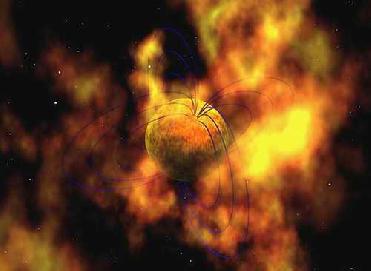
Astronomers think soft gamma-ray repeaters are magnetars -- neutron stars with a super-strong magnetic field (blue arcs in this artist's concept). Credit:NASA/Goddard Space Flight Center Conceptual Image Lab
WASHINGTON (BNS): With the help of NASA's Swift satellite and Fermi Gamma-ray Space Telescope, astronomers are watching frequent blasts from a stellar remnant 30,000 light-years away. The high-energy fireworks arise from a rare type of neutron star known as a soft-gamma-ray repeater. Such objects unpredictably send out a series of X-ray and gamma ray flares, astronomers say.
“At times, this remarkable object has erupted with more than a hundred flares in as little as 20 minutes,” said Loredana Vetere, who is coordinating the Swift observations at Pennsylvania State University. “The most intense flares emitted more total energy than the sun does in 20 years,” she said.
The US premier space agency, NASA said that the object, which has long been known as an X-ray source, lies in the southern constellation Norma. During the last two years, astronomers have identified pulsing radio and X-ray signals from it. The object began a series of modest eruptions on October 3, 2008, and then settled down. It roared back to life on January 22 this year with an intense episode.
Because of the recent outbursts, astronomers have said that this is the sixth known soft-gamma-ray repeater. In 2004, a giant flare from another soft-gamma-ray repeater was so intense it measurably affected Earth's upper atmosphere from 50,000 light-years away.
NASA said that scientists think the source is a spinning neutron star, which is the super dense, city-sized remains of an exploded star. “Although only about 12 miles across, a neutron star contains more mass than the sun. The object has been cataloged as SGR J1550-5418,” NASA said.
While neutron stars typically possess intense magnetic fields, a subgroup displays fields 1,000 times stronger. These so-called magnetars have the strongest magnetic fields of any known object in the universe. SGR J1550-5418, which rotates once every 2.07 seconds, holds the record for the fastest-spinning magnetar. Astronomers think magnetars power their flares by tapping into the tremendous energy of their magnetic fields.
“The ability of Fermi's gamma-ray burst monitor to resolve the fine structure within these events will help us better understand how magnetars unleash their energy,” said Chryssa Kouveliotou, an astrophysicist at NASA's Marshall Space Flight Center in Huntsville, Alaska. The object has triggered the instrument more than 95 times since January 22.
Using data from Swift's X-ray telescope, Jules Halpern at Columbia University captured the first "light echoes" ever seen from a soft-gamma-ray repeater. Images acquired when the latest flaring episode began show what appear to be expanding halos around the source. Multiple rings form as X-rays interact with dust clouds at different distances, with closer clouds producing larger rings. Both the rings and their apparent expansion are an illusion caused by the finite speed of light and the longer path the scattered light must travel.
Halpern said that x-rays from the brightest bursts scatter off of dust clouds between the star and us. “As a result, we don't really know the distance to this object as well as we would like. These images will help us make a more precise measurement and also determine the distance to the dust clouds,” Halpern said.
NASA's Wind satellite, the joint NASA-Japan Suzaku mission, and the European Space Agency's INTEGRAL satellite also have detected flares from SGR J1550-5418.
 Previous Article
Previous Article













The Indian Air Force, in its flight trials evaluation report submitted before the Defence Ministry l..
view articleAn insight into the Medium Multi-Role Combat Aircraft competition...
view articleSky enthusiasts can now spot the International Space Station (ISS) commanded by Indian-American astr..
view article